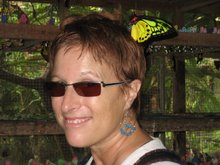 Sapa is a hill town located in northwestern Vietnam, and it is all about the amazing hill tribes, their villages, and terraced rice paddy landscape. To visit the tribal villages, you must have a licensed tour guide with you. We hiked through the hill towns and then left on a five-day, 4WD trek, through more hills and villages, with one home stay, back to Hanoi.
Sapa is a hill town located in northwestern Vietnam, and it is all about the amazing hill tribes, their villages, and terraced rice paddy landscape. To visit the tribal villages, you must have a licensed tour guide with you. We hiked through the hill towns and then left on a five-day, 4WD trek, through more hills and villages, with one home stay, back to Hanoi.The women below are from the Black Zhao hill tribe, where blackened teeth are considered beautiful.

One of our hiking guides, April (not her real name), age 19, is from one of the hill tribes. She told us a bit about her family and arranged marriages in Vietnam. Her sister, at age 14, was betrothed by her parents to a man she didn't know. She committed suicide "by eating poison leaf." When April turned 14, her parents yet again arranged a marriage for her with a man she didn't know. She told her parents she was too young to marry, she didn't know the man, and she wanted to go to university to study music. Her parents declared that if she didn't go through with the marriage, she would no longer be their daughter. So she passed on the marriage, finished school, studied music, and now works as a tour guide. While she gets settled, she is living with her other married sister's family. Her parents passed away while April was in school. I told April that I thought she was very smart and courageous, and that it takes women standing up and saying no for sexist practices to change and women to control their own lives. When I told her about bride burnings in India, where brides are not only often betrothed, but must provide an ample dowry or the groom's family might douse her in gasoline and light her on fire, April was surprised to find that arranged marriage and other such practices occur in other countries as well. (Bride burnings are currently illegal in India but they still happen. One such incidence was reported in the newspaper while we were there.)
Women have come a long way in Vietnam (and most of Asia), but sexism and misogyny are still alive. When I mentioned to one 20-something man that women own most businesses in Vietnam, he agreed, but said that was because shop-owning is often considered too "simple" a vocation for men. When we arranged our 5-day trek with the tour agency owner, who had assigned April to us earlier in the week, he assured us that our new guide was "very good-- a man--not just a girl." Gar. We assured him that April had done a fabulous, knowledgeable job, and we would ask for her again.
So we had one paid tour date with April. Then she invited us for a hike the next day, her day off, "just for fun"! We hiked on and off trail, up and down rice paddies and through villages. At some more vertical points I felt like handicapped Clara trying to keep up with mountain goat Heidi on Grandfather's mountain. (But I was vindicated during my visit home, when I hiked sweat- and huffing/puffing-free through previously challenging trails.)
Here's a picture of the kitchen area in one of the village homes.

On our trek back to Hanoi, we visited villages Lao Cai, Lai Chau, Son La, and Dien Bien Phu, site of the 1954 57-day siege between the French and Vietnamese that ended French occupation in Vietnam and paved the way for Vietnam's division into North and South. The Vietnamese, with paltry arms compared to the French, won Dien Bien Phu, with the French general committing suicide. Subsequently, before the American/Vietnamese war, the French warned the Americans that interfering in Vietnam would be ill advised. [cough]



Vietnamese Hero Who Through Himself In Front of a Cannon Blast
to Save the Rest of His Company



Duong (left of me) started talking to us as we walked through one of the villages.

Duong invited us into her home for tea, where we met the rest of her family. Duong has had a couple years of English and showed us her textbooks. As we have found for ourselves with foreign languages, Duong could understand some of what we said but hesitated in speaking herself. Manh, our guide, was our interpreter. As we were leaving, Duong's mother invited us for lunch too.

Duong's home was much like the home where we spent the night on our homestay. The family lives on the second floor, with rooms divided by sheets strung between the walls and support columns. Often, livestock live on the ground floor.
More pics from Sapa hikes ~


Scorpions and snakes in liquor are popular drinks, especially to sell to tourists. When Eric had a glass of wine that had been stewing in goat testicles, I made him brush his teeth before coming near me.
























